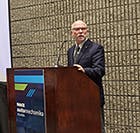ATLANTA – Over 85 percent of the collision repairs made in the United States are performed by independent repair shops. And today, many of these shops are torn between repairing a car according to the OEM specified procedures or to the “industry standards” preferred by the insurer paying for the repair.
Increasingly, the two are not the same. And both the Automotive Service Association (ASA) and the Alliance of Automobile Manufacturers feel the time has come to require insurers, through legislation, to allow repairers to follow OEM guidelines and to compensate them for following the OEM process.
At the joint press conference on Wednesday held during NACE Automechanika Altanta, Darrell Amberson, ASA Immediate Past Chairman, shared, “Years ago, we were a very generic repair industry…but due to changing technologies we’ve moved to a very procedure-specific repair industry today.” He adds, “Unfortunately, there are insurers that want us to deviate from some of these factory repair procedures, using phrases like ‘industry standards’ that nobody seems to have clear definition of.”
The most current example of this deviation is the pre- and post- vehicle system scan, required by many OEMs. Dan Risley, president of ASA, points out that the need is not just to identify any issues that exist with a vehicle prior to repair, but to insure no new issues – especially those related to modern Advanced Driver Assistance Systems – are created in the course of the repair. And even though the scans are a specified step in the OEM repair process, many insurers will not compensate the repairer for performing the scans.
Additionally, ASA and AAM representatives shared that repair shops that bow to insurer demands and complete a repair that falls outside the manufacturers’ guidelines can result in the delivery of an unsafe vehicle to a consumer and increased liability risk for the shop.
To address these issues, both ASA and the Alliance of Automobile Manufacturers announced their intention to lobby for legislation, both at the federal and state level, in 2019. The objective is to prohibit insurers from requiring a shop to perform a repair that is not in line with OEM procedures and to protect both shops and consumers by requiring that car be repaired to the OEM specific standards.



